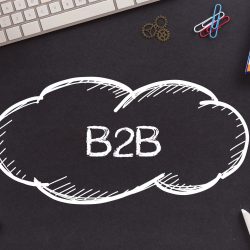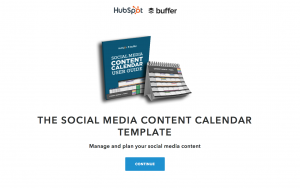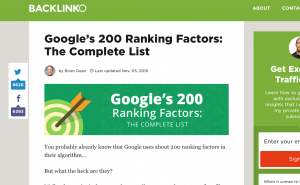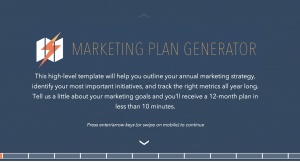
- Author: Andy Hagans, Co-Founder of FunnelUp.
- Last Updated: December 26, 2017.
- Read Time: 13 minutes.
A B2B marketing funnel can be your sales team’s best friend — or its worst enemy.
Your marketing funnel generates traffic, which generates leads. The leads are then qualified as sales prospects, and ultimately closed by your sales team (hopefully, at a high rate).
Any point of failure, or even underperformance, along your marketing funnel means your sales team will struggle to close new accounts. Perhaps there aren’t enough leads. Or there are many low-quality leads, but too few truly qualified leads.
By contrast, a high-performing B2B marketing funnel will generate a huge number of qualified leads that close at a high rate. Sales targets get met or exceeded, and sales reps love the marketing department!
In this guide, I’m going to explain how to build a simple but high-performing B2B marketing funnel that generates, nurtures and qualifies leads in one fell swoop.
I’ll even provide three specific funnel models — funnel “blueprints,” if you will — that leverage currents trends in content marketing and social media advertising to outperform.
But first, let’s review the “duties” of a B2B marketing funnel versus a sales funnel.
The 3 Requirements of a Successful B2B Marketing Funnel
The marketing funnel builds brand awareness, attracts a stream of targeted traffic, and generates leads from that traffic stream.
Once the lead is generated, it goes into the sales funnel, where the lead may be qualified as a prospect, nurtured, contacted by your sales team, and ultimately closed as a new account.
Problems occur when the marketing funnel and sales funnel aren’t well-aligned. If the marketing funnel is focused mainly on lead quality, at the expense of volume — or vise versa — it will be very hard for your sales team to meet its goals.
So I believe that an “all star” B2B marketing funnel should go “above and beyond,” and meet the following three criteria.
REQUIREMENT 1: Your marketing funnel should deliver a high volume of leads. Perhaps this is “obvious,” but it isn’t always easy. In the quest to target your ideal customer, your funnel can become very narrow; and as a result your leads are high quality, but too few in number.
Thankfully, the rise of content marketing and massive social media ad networks make it easier and cheaper to generate qualified leads.
But many B2B marketing departments struggle here. “Old school” B2B content marketing devices, such as whitepapers and ebooks, often under-perform on social media ad platforms. Even if the campaigns reach the right audience, the response rate is low.
Instead, I recommend youcreate “nurturing” type content that directly relates to your product or service (and targets your ideal customer), but doesn’t necessarily advertise your product or service itself. Don’t worry, we’ll identify some specific examples of this later in the article.
The result is a creative that performs better on the social ad platforms, which reward you with more reach and volume at a lower cost in return for optimizing your campaigns for their platform’s context.
REQUIREMENT 2: Your marketing funnel should qualify leads from the very beginning, before sending them to the sales team. Modern opt-in forms — especially in the context of a high-trust, low-pressure offer — can integrate additional form fields with little to no drop-off in conversion rate.
If your lead volume is relatively low, and it is cost- and time-effective for your sales team to manually review each incoming lead, then lead qualification at the opt-in stage is less important.
But if you deal with a high volume of leads, the time and cost savings can be huge. Your sales team will be receiving MQLs (Marketing Qualified Leads) rather than a mix of qualified and non-qualified leads.
But more importantly, your marketing funnel — and the people running it — will be aligning more tightly with your sales team. Rather than optimizing your marketing campaigns to generate “more leads,” you’ll have the data locally — in the marketing department — to optimize for a higher volume of qualified leads.
REQUIREMENT 3: Your marketing funnel should nurture leads with high-value, low-pressure content that builds brand authority and trust. The “old school” B2B marketing playbook uses content marketing to great effect. Whitepapers, ebooks, case studies and so on can narrowly target ideal customers who are somewhere in the buying cycle for your company’s products and services.
As we discussed above, however, “nurturing” type B2B content that relates to (but doesn’t directly sell) your products and services will tend to perform much better on social ad platforms.
The good news is, this type of “low-pressure” (but highly targeted) content will establish trust with qualified leads who enter your sales funnel.
The decision you will face is whether to further nurture and qualify these opt-in’s with an email drip campaign, or hand them off immediately to your sales team.
In sales funnels with more time-sensitive buying cycles, it usually makes sense to send qualified leads immediately into the sales funnel.But it may make sense to send opt-in’s into a more MOFU (Middle Of The Funnel) type drip campaign, where you can make them aware of your specific products and services, plus further qualify them via offers for demo’s, webinars, and so on.
Either way, the customer’s relationship with your brand began with a piece of high-value, low-pressure content. The brand trust, authority, and goodwill created by this type of content will pay off later in the sales process.
So What’s My TLDR;?
An all-star B2B marketing funnel will:
- Generate a ton of targeted leads, cheaply via social ad platforms, using cutting-edge content marketing;
- Pre-qualify those leads at the very beginning, aligning the marketing funnel to generate high-value MQLs (rather than mixed-value non-qualified leads); and
- Nurture new leads with high-value content that builds trust and authority, helping your sales team close more new accounts, since prospects have already developed a positive relationship with your brand.
At this point, I think we’ve talked enough “theory.” Let’s show some specific B2B funnel blueprints, along with real-world examples that crush it!
B2B Marketing Funnel #1: The 1-2 Punch Funnel
The 1-2 punch is deceptively simple, but it can be amazingly effective on social ad platforms. Here’s how it works.
First, you target “cold” traffic to a relevant, social-friendly un-gated piece of content. This is the jab… the “one” punch.
Next, you retarget the newly-”warm” traffic to a related, gated piece of content (a squeeze page). This is the right cross… the “two” punch.
Again, the 1-2 Punch Funnel seems simple (and it is). But don’t underestimate its power.
On social ad platforms, many B2B marketers make the mistake of primarily promoting their gated content (squeeze pages, lead magnets, etc.) The trouble is, gated content — especially in B2B verticals — will often receive a hostile response from social media users, even those who are highly targeted.
As a result of the poor engagement your campaign receives, the social ad platforms will decrease your campaign reach and increase your CPM rates, essentially tanking your campaign. In other words, the social ad platforms “punish” advertisers who use ad creatives that don’t get high positive engagement.
So the 1-2 Punch Funnel relies on your “jab” — the social-friendly, un-gated piece of content — to be the “workhorse” of social ad campaigns. Since this type content of content will receive much better response (and positive engagement) from users, it’s the best type of creative to serve to targeted “cold” traffic.
Want an example? I’m going to use Hubspot content as specific pieces which are worth modeling (not copying!). Note that I have no connection whatsoever to Hubspot, they are just a great example to use because they create so much high-quality content geared towards B2B audiences.
As a “jab”, Hubspot might launch an ad campaign directing targeted “cold” traffic to the following un-gated blog post: “How to Learn Social Media Marketing: 30 Resources for a Beginner.”
Even if much of this cold traffic lacks existing familiarity with the Hubspot brand, social-friendly content like this will usually receive high positive engagement. When the content receives high positive engagement on the social ad platform, the campaign will be rewarded with extensive reach, and discounted CPM rates.
Any traffic that visits the un-gated blog post can be pixeled, and added to a “warm” audience on the social ad platform. This “warm” audience can then be retargeted to a related gated piece of content (the “right cross.”)
In this theoretical example, Hubspot could retarget the “warm” audience to their squeeze page offering “The Social Media Content Calendar Template.”

By using the 1-2 punch, the vast majority of traffic on the social ad platform will be seeing your social-friendly un-gated content (the “jab”); only “warm” traffic that clicks through to the un-gated content will be retargeted to the more aggressive gated content offer (the “right cross”.)
Note: opt-in’s that you generate with a 1-2 Punch Funnel may be considered qualified, or not, depending on two things.
First, if you require additional qualifying data fields in your opt-in form (and qualify / disqualify leads accordingly), you can qualify leads from the beginning.
Second, to the extent that the lead magnet itself reflects buyer intent, can be construed somewhat as a qualifying factor.
In the case of our theoretical example, “The Social Media Content Calendar Template” probably doesn’t reflect strong buyer intent. Moreover, the opt-in form only asks for email address, rather than additional qualifying data fields (such as “Your company size”). As such, leads from this theoretical campaign might be best placed into an email drip campaign, whereby a second content offer — one that more strongly reflects buyer intent — allows the lead to “raise their hand” and move down the funnel as an official MQL.
B2B Marketing Funnel #2: The Content Upgrade Funnel
The Content Upgrade Funnel is very similar to the 1-2 Punch Funnel… but it’s even simpler.
Essentially, you need a social-friendly un-gated piece of content that relates to your niche.
And again, this piece of social-friendly, un-gated content will act as the “workhorse” for your social ad campaigns. The social ad platforms will “reward” you for using this type of content, with lower CPMs, and higher reach. As such, it’s the best type of creative to serve to targeted “cold” traffic.
But instead of retargeting these (now “warm”) visitors to a related gated piece of content via the social ad platform, you will present visitors with your gated content offer within the original un-gated content.
Typically, the offer will ask for the visitor’s email address in exchange for receiving a PDF that is tightly related to the un-gated content they’re already reading. But you can even offer the visitor a PDF version of the same exact un-gated content they’re currently reading, and you will still receive plenty of opt-in’s!
As a real world example, Backlinko published an un-gated, social-friendly piece of content titled “Google’s 200 Ranking Factors: The Complete List.”

So in this case the gated offer is a difference piece of content, but it’s very tightly related. For an even easier implementation, Backlinko could offer visitors a PDF version of the original article (Google’s 200 Ranking Factors: The Complete List).
I’m a huge fan of this simple implementation because it only requires one piece of (very good) content. So you have the ability to quickly test multiple un-gated content pieces, using PDF versions of each article as its Content Upgrade.
Those which perform the best can become your “workhorse” campaigns on social ad platforms. It’s a cheap way to “warm up” targeted “cold” traffic, plus receive targeted opt-in’s.
Again, based on your opt-in form, as well as the buyer intent reflected in the content piece, you will need to decide if these opt-ins represent qualifieds, or if they leads that now need qualified.
If they’re the latter, you can place the leads into an email drip campaign, and qualify them with offers for demo’s, whitepapers, webinars, and similar offers that reflect stronger intent.
B2B Marketing Funnel #3: The Online Tool Funnel
The third funnel we’ll discuss here is the Online Tool Funnel. Depending on your technical resources, this may be the hardest (or easiest) funnel to execute.
The Online Tool Funnel depends on creating a unique, value-added online tool with a function that’s related to your niche (and ideally, your products and services).
To the extent the user interface, design, and input form looks “cool” and “sexy,” an online tool will tend to get high positive engagement on social ad platforms.
Why?
Well, a tool, is cool… web visitors think so, anyway.
Perhaps this is because there are relatively few online tools compared to the number of content articles published. Or maybe visitors intuitively understand that a tool is usually “harder” to create than a content article.
Either way, a tool input form is the perfect lead generation mechanism. Your tool input screen should ask visitors for their email address in exchange for the ability to view a PDF or email report of the tool’s output.
I’d recommend including a qualifying field or two here, too, simply because visitors probably won’t object. If they want to use the online tool, they’re usually happy to trade a bit of personal information in exchange.
If qualified, a lead can be sent as an MQL directly to your sales team, or, you can qualify leads further with offers sent within an email drip campaign.

As an aside, Hubspot’s marketing team is amazing. They have truly mastered the art of B2B marketing funnels!
Which B2B Marketing Funnel Is Right For You?
The three funnels above can work in almost any B2B niche.
The truth is, most high-performing marketing funnels aren’t the “first” funnel. Or the second, or third, or even fourth.
The best B2B marketing funnels usually originate from marketers that have a funnel system, whereby they continually create, test, and optimize new funnels!
This needn’t be overwhelming. Even one new funnel per month is often enough to continually improve your funnel performance against former benchmarks.
The best place to start usually begins by identifying what funnel pieces you already have. For instance, if you already have a social-friendly, un-gated piece of content that performs well on social ad platforms, it’s trivial to build a Content Upgrade Funnel that offers visitors a PDF version of the same article.
Boom! You have a new funnel.
As long as you’re willing to test, iterate, and build new funnels, you should have the wind at your back!
